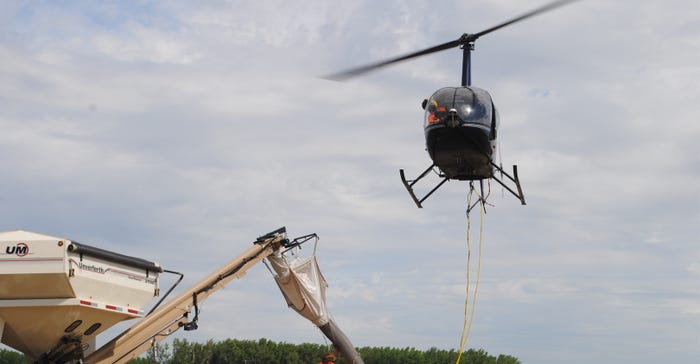
Brent Wulf can fly agriculture-related applications with airplanes and helicopters, but he prefers being in a helicopter. The Bennington, Neb., pilot is the owner and operator of Hexagon Helicopters, helping farmers seed cover crops into standing crops — along with fertilizer and other applications —around the region.
“I started flying lessons in 1997 at the local airport where I grew up in southeast Kansas,” Wulf recalls. “I towed banners and gliders and hauled skydivers as my first flying jobs, until I started flying for agriculture jobs in 2004.”
Wulf says that seeding cover crops is a natural fit for his business. “It generally falls after the summer fungicide spraying and before any fall pasture spraying starts,” he says. “It’s just one more service we can provide to our customers.”
Last year, about one-third of Wulf’s cover crop customers were trying the service for the first time. “The various cost-share programs available for seeding cover crops seem to be working as designed, because a good portion of the first-time producers are enrolled in a cost-share program,” Wulf says.
“Many of our customers said they wanted to try aerial seeding but have had trouble finding a local applicator that is able to do it,” he adds. Wulf’s customers range in acres covered from 120 to more than 500 acres. “Most started with smaller acreages and very simple seed mixtures, like straight cereal rye or a three-way mixture of cereal rye, radishes and turnips,” he says.
More experienced cover croppers are seeding more acres with more complex seed mixtures, depending on their goals. “Some producers went with cereal rye for simplicity and cost savings, while others tried a more varied mixture of three to five species, or even a 15-way mixture,” Wulf says.
The problem with rye last fall was availability during seeding time. “There were several producers who substituted part or all of the rye they had planned with wheat,” he says.
Nebraska Farmer caught up with Wulf while he was aerially seeding a cover crop mixture into standing corn on 120 acres at Chad Christianson’s farm south of Hooper, Neb. Christianson decided to seed his cover crops into corn at the V3 to V5 growth stage, so the covers can be established before shading in the row.
On the day we visited, Christianson was seeding 13-way mixtures that included oats, winter wheat, vetch, annual ryegrass, buckwheat, rapeseed, radishes, clovers and lentils.
“My main goal is soil health, but also nutrient cycling, weed suppression and maybe a little nitrogen in the later part of the season from clovers,” Christianson says. “I’m hoping to relieve compaction, improve water infiltration, add pollinators and get phosphorus release from the buckwheat, as just a few of the jobs these cover crops can perform for my soils.”
Seeding is accomplished with the helicopter and a spreader bucket carried beneath. “We custom-built this bucket in-house and were recently granted a patent on several of the unique features we incorporated,” Wulf says. “I looked at several buckets that are built but wasn’t happy with any of the overall products because they were built to do heavy rates of fertilizer and lacked the adjustability and uniform spread pattern required for seeding cover crops.”
His bucket has a small gas engine that runs the spreader, with Wulf controlling the gate from his helicopter.
Wulf’s patented bucket, which can carry as much as 400 pounds of seed at a time, applied more than 600,000 pounds of material between June urea work and cover crop applications last season.
“We can put out any seed at any rate the customer requests,” Wulf says. “Typical rates can vary anywhere from 5 pounds of turnips to over 100 pounds of cereal rye, depending on what the customer wants. The average rate is 50 to 60 pounds per acre.”
At Christianson’s farm, Wulf was seeding the mixture at rates between 35 to 40 pounds per acre. The seeder bucket hangs about 20 feet below his helicopter, and about 50 feet above the field surface during seeding.
Wulf has a tender wagon set up with the seed, so after the seeder is empty, he flies back to the tender and gently lowers the seeder to the ground while hovering above. It takes less than 30 seconds for his ground crew to fill the seeder again, so the operation goes quickly.
Flying at about 50 miles per hour — with a seed spread distribution of 50 feet on Christianson’s farm — Wulf used GPS to seed 10 acres in about five minutes, depending on the seeding rate and flying time back to the tender bin.
“On lighter seed like oats or ryegrass, we will go for a 50-foot swath,” Wulf says. “For seed like cereal rye, we have spread out to 75 feet with great coverage. For urea, we can spread 75 feet, but have spread as wide as 100 feet, unless we were limited by the flow rate out of the bucket from sticky material.”
Christianson says that he met Wulf a couple of years ago and began talking about his goals for seeding cover crops. “Brent really wants to understand the philosophy of cover crops, so he can do a good job for his customers,” Christianson says. “Although he is not directly involved in farming, he has learned about cover crops and soil health over time, and that helps him when he gets to the field.”
Quality seed is important. “If a farmer wants to buy seed from a local source, they need to make sure it is good quality and has been properly stored,” Wulf says. “We know of producers who purchased locally raised rye that had been harvested wet, so the seed was moldy and unfit to seed.”
Although Christianson was seeding in mid-June, most cover crop seeding typically starts the first week of August on seed cornfields.
“Our busiest time would be the first two weeks of September on standing corn, and then commencing on standing soybeans closer to the last week of September” when the beans begin dropping leaves and the canopy thins, Wulf says. “On the other end of the range, we had a customer request seeding the last week of October in a field they had planned on drilling but ran out of time.”
Just like other field treatments, wind and rain can be obstacles. “In 2018, we had plenty of rain, which made for excellent germination, but it made planning a little tough,” Wulf says. “Rain during application causes problems because the spreader bucket is open on top. Any showers that come along cause seed to stick to the sides of the bucket, and there are issues with flow and calibration.”
The upper limit on wind speed during seeding is about 15 miles per hour, but 10 mph or less is ideal. “I have seeded in winds over 30 mph with good results, but it is hard on the helicopter and it makes for an uncomfortable ride,” Wulf says.
Learn more about Wulf’s cover crop seeding business by calling 402-885-0189.
About the Author(s)
You May Also Like






